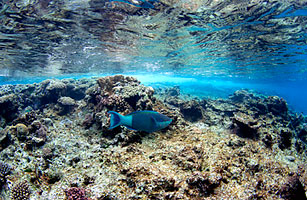
Shark humor has its time and place, but not when I’m snorkeling somewhere called Shark Bay. At the Heron Island Research Station, a laboratory on the teardrop-shaped atoll 45 miles off Australia’s east coast, the suntanned, chirpy station manager gives a parting wave to the three students who are taking me out for my first look at the legendary corals of the Great Barrier Reef. “Just don’t get eaten, will you?” she says. Ha-ha. Happily, there are no sharks in Shark Bay that morning; in fact, there’s not a whole lot of anything. As I follow the students’ snorkels, we pass over circular beds of brown, monochromatic coral and empty expanses of rippled sand. A handful of small, glimmering fish hover in the water column, but they’re the only life we see during an hour-long swim. Where are the schools of coral trout? The famed Maori wrasse? Wading back to shore, one of the students shrugs: “Sorry there wasn’t more.”
The Great Barrier Reef is one of the world’s natural wonders, covering an area larger than Italy and drawing nearly 2 million tourists every year to boat, swim, snorkel and dive amid its elaborate flora and fauna. It generates some $6 billion in revenue for Australia annually and provides employment to more than 50,000 people. It’s also one of the planet’s most fragile ecosystems, home to more than 11,000 species that live, if not necessarily in harmony, in a carefully orchestrated symbiotic balance. At the foundation of this giant ecological and commercial enterprise is one tiny marine organism: the coral.
That foundation is no longer solid. Corals build colonies that secrete calcium carbonate to form ocean reefs. When they’re healthy, coral reefs provide shelter and food for animals all along the food chain, including the top: us. Across the planet, half a billion people rely, directly and indirectly, on corals for their living. That’s why what happens to the 9,000-year-old Great Barrier Reef, as well as to other reefs worldwide, is critical. The recent Queensland floods were most notably tragic for the lives lost and property destroyed. But they have also hurt the Great Barrier Reef by funneling into the ocean vast plumes of freshwater and agricultural runoff that could severely damage the coral. Besides the extreme rain that sparked the floods, rising ocean temperatures, changes to the ocean’s chemistry and the global trade in natural resources — all symptoms of our fossil-fuel economy — are waging a multifront war on the marine environment. “You can’t walk into a forest and start hacking at branches and killing off animals and denuding the forest cover without killing the trees,” says Justin Marshall, a marine biologist at the University of Queensland. “The outlook for the whole reef is poor.”